Astronomers took a picture of the Fomalhaut Dust Belts using NASA’s James Webb Space Telescope. They did this to study the first asteroid belt ever seen outside of our solar system in infrared light. The researchers were surprised to find that the dusty structures were more intricate than the dust belts found in our solar system’s asteroids and Kuiper belt.
What did Webb unveil about the inner belts around Fomalhaut?
There are three belts that extend out to 14 billion miles from the star. This is 150 times the distance between Earth and the Sun. The outermost belt is about twice as big as our solar system’s Kuiper Belt, which is made up of small objects and cold dust beyond Neptune. Webb unveiled the inner belts, which had never been seen before.
Debris Disks:
You can see the brightest star in the southern constellation Piscis Austrinus without a telescope. Belts surround this young, hot star. Dusty belts are made up of debris from collisions of larger bodies like asteroids and comets. They are often called “debris disks.”
Lead author András Gáspár:
András Gáspár from the University of Arizona in Tucson said that Fomalhaut Dust Belts is like a model for debris disks found in other parts of our galaxy. This is because it has similar parts to our own planetary system. He is the lead author of a new paper that talks about these findings. We can create a rough sketch of a planetary system by studying the patterns in these rings. However, we need a clearer picture to confirm the existence of the planets.
What is the function of Webb in observing debris disks?
The outermost belt has been sharply imaged by the Hubble Space Telescope, Herschel Space Observatory, and ALMA. But they couldn’t find any structure inside it. Webb has used infrared light to observe the inner belts for the first time. Webb is great at detecting the heat given off by dust in the inner regions.
Schuyler Wolff:
Schuyler Wolff, a team member from the University of Arizona, mentioned that we can now observe inner belts that were previously invisible. Hubble, ALMA, and Webb are working together to get a complete picture of the debris disks around different stars. Wolff said, “With Hubble and ALMA, we were able to image a bunch of Kuiper Belt analogs, and we’ve learned loads about how outer disks form and evolve,” said Wolff.
Moreover, Wolff added: “But we need Webb to allow us to image a dozen or so asteroid belts elsewhere. We can learn just as much about the inner warm regions of these disks as Hubble and ALMA taught us about the colder outer regions.”
What is the cause of the formation of these belts, and what role does Neptune play in the Kuiper Belt?

These belts were probably formed by the gravity of planets that we can’t see. Jupiter keeps the asteroid belt in place in our solar system, while Neptune shapes the inner edge of the Kuiper Belt. There might be unknown objects beyond the outer edge that guide it. As Webb takes more pictures of different systems, we’ll discover how their planets are arranged.
What IRAS discovered in 1983?
NASA’s Infrared Astronomical Satellite (IRAS) discovered Fomalhaut Dust Belts in 1983. Scientists have found evidence of the ring using telescopes on Mauna Kea, Hawaii, NASA’s Spitzer Space Telescope, and Caltech’s Submillimeter Observatory.
George Rieke:
George Rieke, a member of the team and the U.S. science lead for Webb’s Mid-Infrared Instrument (MIRI), compared the belts around Fomalhaut Dust Belts to a mystery novel, wondering where the planets are located. There might be a fascinating planetary system around the star.
Wolff said that they were surprised by the complex structure of the asteroid belt, which had a second intermediate belt and a broader asteroid belt. Astronomers get excited when they see gaps and rings in a structure because they think there might be a planet hiding in there!
The great dust cloud:
Webb captured an image of something called “the great dust cloud,” which could mean that two protoplanetary bodies collided in the outer ring. This feature is not the same as the suspected planet that was initially observed by Hubble in 2008 within the outer ring. The object has disappeared by 2014, according to further Hubble sightings. It is possible that this newly discovered phenomenon, like the one before it, is an expanding cloud of incredibly fine dust from two frozen bodies that collided.
What was the theory proposed by Immanuel Kant and Pierre-Simon Laplace?
In the late 1700s, two astronomers named Immanuel Kant and Pierre-Simon Laplace came up with a theory that the Sun and planets were formed from a rotating gas cloud. They believed that the cloud collapsed and flattened due to gravity, creating a protoplanetary disk around the star.
Can debris disks provide information about earth-sized planets?
Debris disks come after planets are formed and the gas in the system is gone. Asteroids are crashing into each other and breaking apart into lots of dust and debris. By studying the dust around exoplanets, scientists can learn about the structure of the planetary system. This includes information about small objects like earth-sized planets and asteroids that are too tiny to see on their own.





